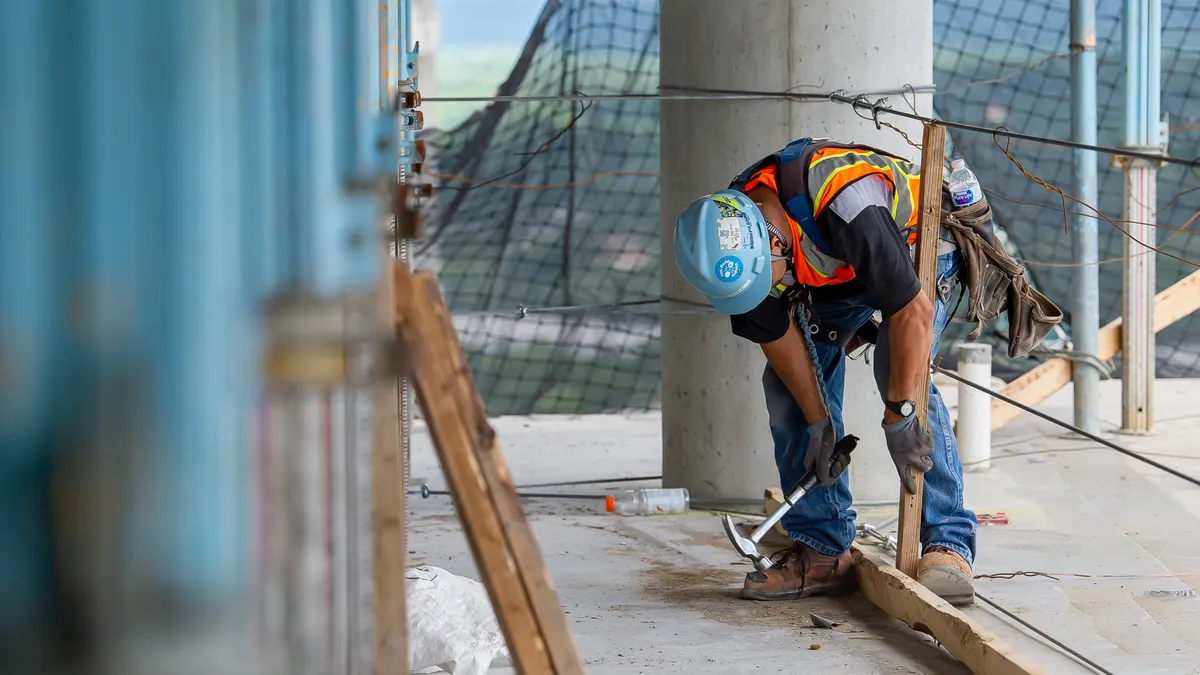Dive Brief:
- As labor issues plague the construction industry with no signs of abatement, a new survey from Associated General Contractors of America and San Francisco-based construction software firm Autodesk demonstrates the degree to which firms are struggling.
- Among the 1,401 respondents polled from a breadth of companies, 85% of construction firms have open positions that they are trying to fill. Of those businesses, 88% are having issues filling some of the positions, particularly among the craft workforce, according to an AGC press release on the survey.
- These difficulties are not relegated to one aspect or facet of construction. Contractors of all sizes, revenue amounts and specializations reported issues finding workers, per the release.
Dive Insight:
One of the main problems contractors face, according to the survey, is a lack of qualifications — 68% of firms reported that applicants lacked the skills needed to work in construction.
“It is time to rethink the way the nation educates and prepares workers,” Ken Simonson, the chief economist at AGC, told listeners during a webinar last week announcing the results of the survey.
Technology has offered firms a way to train employees and make their work more accurate. As a means to upskill employees, 41% of firms are boosting spending on training and professional development programs, 25% are enhancing their online and video training capabilities and 14% are using augmented and virtual reality technology to better train workers, according to the survey.
In addition, tech is a valuable tool for finding people — 75% of respondents agreed that their use of technology helps them recruit talent into their firms, per the survey, while a similar share said diversifying their current workforce is critical to strengthening their future business.
On construction jobs in the next five years, 44% of respondents said that AI and robotics will positively impact construction costs by automating manual, error-prone tasks. In addition, 41% said AI and robotics will improve the quality of construction jobs and make construction pros safer and more productive.
However, not all respondents had a positive take. Of all participants, 17% said AI and robotics will negatively impact the construction job market by eliminating positions, while 30% expect no effect.
Find what works
In their scramble for workers, contractors have offered varying benefits to entice young professionals to join their ranks. Many are financial — 81% of firms have raised base pay rates for their workers during the past year, according to the survey. In addition, 44% are providing incentives and bonuses and 26% have also improved their benefits packages.
Part of these incentives also comes down to what younger workers want, said Bill Ryan, education coordinator at Helena, Montana-based Dick Anderson Construction. Ryan pointed to the fact that while overtime pay is desirable, for example, younger workers value their free time more.
“Their motivation is their free time, and what they get to do with their free time,” Ryan said during the webinar.
Ryan also said that there’s a cultural shift occurring in the industry. Gone are the days of workers who will tolerate being belittled or badgered on a jobsite.
“The reason there’s so few of us in the room is because we survived the old way,” Ryan said, referring to older workers. “We survived being berated, we survived being yelled at, that doesn’t work with the current generation.”
Instead, he said the key is to find out what drives younger workers today.
“It’s a big puzzle, and we have to find the right pieces and put them in the right places to motivate, and to find out what the motivations are, for the younger generations,” Ryan said. “It doesn’t work to just yell and scream and deride people any longer.”













